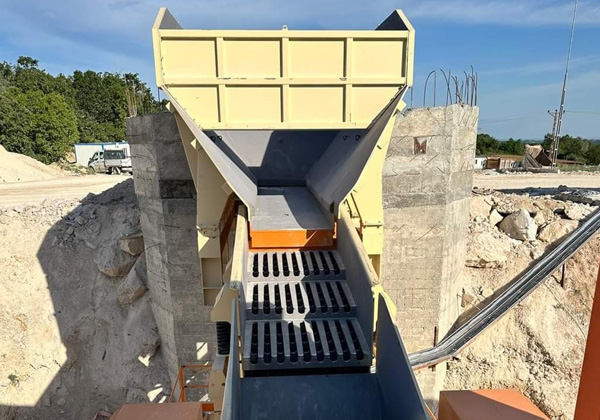A vibrating feeder is a key component in a stone crushing production line, playing an essential role in the continuous and uniform feeding of material into crushers, screens, and other equipment. This feeder is designed to handle materials of varying sizes and weights, ensuring an efficient and steady flow of materials to the next stage of processing. Vibrating feeders are commonly used in a wide range of industries, including mining, quarrying, construction, and recycling, to provide reliable feeding systems that ensure optimal crushing and screening.
Function and Importance
The vibrating feeder is a critical part of the stone crushing line. It serves as the first step in the material handling process by feeding raw materials—such as stones, rocks, and aggregates—into the crusher. This process helps to avoid overloading the crusher, ensures the crushers are fed at a constant rate, and improves the overall efficiency of the production line.

The vibrating feeder works by using vibration to move materials along a conveyor or trough. The vibration is typically created by an electromagnetic or mechanical drive. It allows for smooth, uninterrupted material movement, reducing blockages and improving processing times. By controlling the flow of materials, the vibrating feeder ensures that the crusher receives a consistent and controlled amount of material, reducing wear and tear on the crusher and enhancing the crushing process.
Design and Working Principle
The vibrating feeder consists of a trough, a motor, and a vibration mechanism. The trough is usually made of steel and is designed to carry the material along its length. The vibration mechanism typically consists of an electric motor or an eccentric shaft that causes the trough to move in a controlled manner. This movement is often achieved through either electromagnetic or mechanical means.
The electromagnetic feeder uses a vibrating coil that generates oscillations at a specific frequency. The motor driving the system is typically a direct current (DC) type, allowing for precise control over the speed and intensity of the vibration.
On the other hand, mechanical vibrating feeders rely on eccentric shafts or unbalanced flywheels to generate vibration. The vibration amplitude can be adjusted by modifying the speed of the motor, offering flexibility in feeding different materials.
Applications in Stone Crushing Line
In a typical stone crushing line, the vibrating feeder plays several crucial roles:
- Uniform Distribution: The feeder ensures that the material is evenly distributed across the entire width of the crusher, optimizing the efficiency of the crushing process.
- Pre-Screening: Some vibrating feeders come with a built-in screening mechanism, which separates fine materials before they reach the crusher, reducing wear on the crusher and improving its lifespan.
- Increased Efficiency: By providing a steady flow of material, vibrating feeders minimize the risk of equipment damage caused by feeding inconsistencies, which in turn improves overall plant efficiency.
- Adaptability: Whether in a stationary crushing plant or a mobile setup, vibrating feeders can be used to adjust the feed rate based on the type and size of the material, making them versatile in various stone crushing applications.
In summary, a vibrating feeder is a vital component in a stone crushing line. It ensures the efficient and smooth operation of the entire crushing process by providing a consistent flow of material to the crusher. Its ability to handle different types of materials, adjust the feed rate, and prevent blockages makes it indispensable in both small and large-scale stone crushing operations. Whether used in aggregate production or mining applications, a vibrating feeder contributes to maximizing productivity, minimizing downtime, and extending the life of the crusher and other related equipment.

